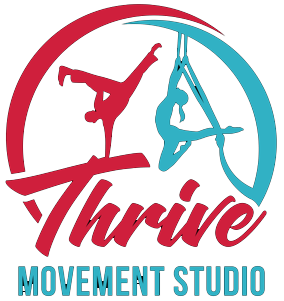 | Thrive Movement Studio |

What is a Warm-up?
Category: circus, thrive movement studio, performance, lifestyle, movement, health, fitness, wellness
What is a warm-up? This sounds like a silly question, but really, what are we doing when we warm-up before physical activity? We often connect the term warm-up with phrases such as, “get the blood moving” or “stretch," but what are we really doing? For me, a good warm-up should be a time where we place close intention on listening and connecting with our bodies. This time is focused on checking in on potential tight or sore spots, maybe even places we are disconnected from. With this information, we would then move through the warm-up with awareness and bring care to these places. If there is an injury, this is a great time to “talk to” the area- see if we are compensating in ways that aren’t helpful or if we have adhesions that we can gently release. This very internal practice can be hard to lead in a kids class as they are often high energy or excited about connecting with friends in class, but I pepper in body awareness activities where I can. With all ages, my hope is that I can inspire interest in connecting more deeply and caring for one’s own body.
If we dig into the “get the blood moving” mantra, we do indeed want to move stagnation out of tissue and bring fresh blood to all places in the body. With the blood comes nutrients. If we have restrictions in soft tissue (such as tightness or injury) we do have compromised blood flow and therefore nourishment. In a warm-up, we are looking to lengthen tissue (unless someone is hyper-mobile- more on that in a minute) and make sure our mechanical system works as it should. This does not mean we are trying for a full split in a warm up. This means we are gently easing into whatever tissue length we have at the moment. I don’t like to push into the end range of flexibility before beginning an extremely dynamic weight bearing activity like aerial- instead we focus on creating stability and whole body connection/integrated movement. Increasing flexibility is great for the end of a session or on its own.
One of the most important parts of our warm up is the nervous system. Aerial, and circus in general, are so dynamic and stellar at stimulating the body’s reaction to the varied training we take part in. Circus excels in its ability to challenge the brain's pathways and stimulate the growth of new pathways. A good warm-up speaks to the nervous system as a whole and gets it connecting from the top of the head to the tip of the toes. The core, so aptly named, coordinates movement in our upper and lower halves. Movement of the legs, stabilization and balance originate in the core. Shoulder stabilization is also core connected- through wrapping the scapula and deepening the ribs back toward the spine. Tightness in the abdomen, trauma and pregnancy/childbirth can cause disconnect from the core. Connecting to deep, easy breath is vital to connecting to the core - and gosh is it hard to do while trying to do really hard things in the air! So we need to deepen that connection when we are not in the air. Finding those deep lower abs can be so hard. But once we do, there is an amazing power of movement that we experience when we are moving with the whole body connected and working as one unit. Helping students find and wake up the core should be a part of any warm up.
Our nervous and muscular systems must fire together to achieve movement. We need to be in a calm state (not in fight or flight mode, feeling anxious, etc.) to really integrate our movement. For me though, movement is my medicine and helps to calm and nourish my nervous system. I start with some movement and breath. The breath is the greatest calming tool for the nervous system. It can be hard to drop into connecting with one's breath (or finding disconnected lower abs) in a group class but I encourage you to find some quiet time; just start breathing and swaying, letting your body speak to where it needs attention, where it is stiff or sore. Let your breath and body be your guide and see if there are parts of your body that aren't’ participating in the movement. Maybe it’s your upper back- invite it to be a part of your movement.
For those who are hyper mobile, it is absolutely vital to be sure all muscle groups are active and firing. Hyper mobile people must rely heavily on the neuromuscular system to keep the joints safe as more flexible or longer ligament and tendon length may not be offering enough joint stability.
Share this:
| circus, thrive movement studio, performance, lifestyle, movement, health, fitness, wellness | 4 |
| All |

